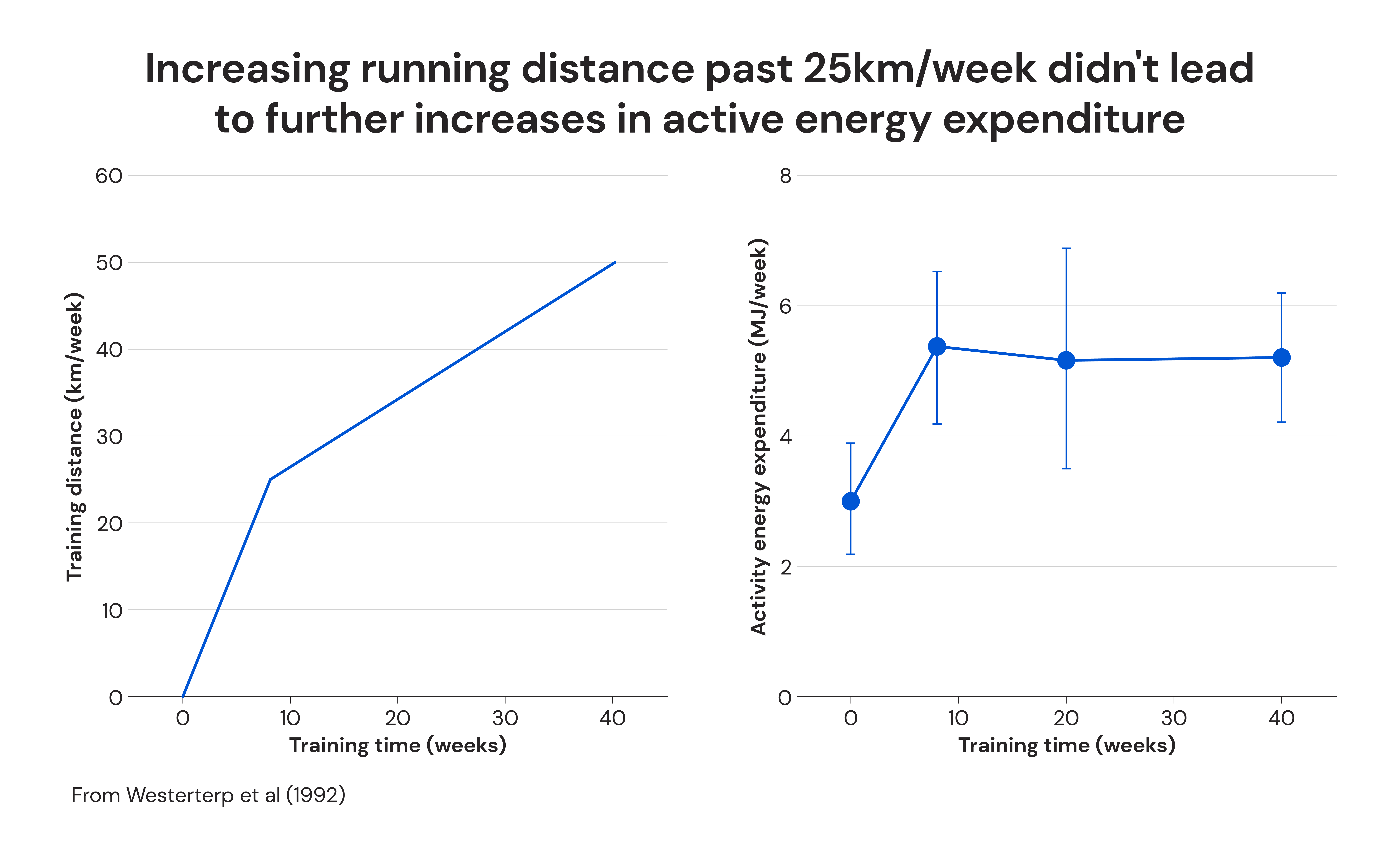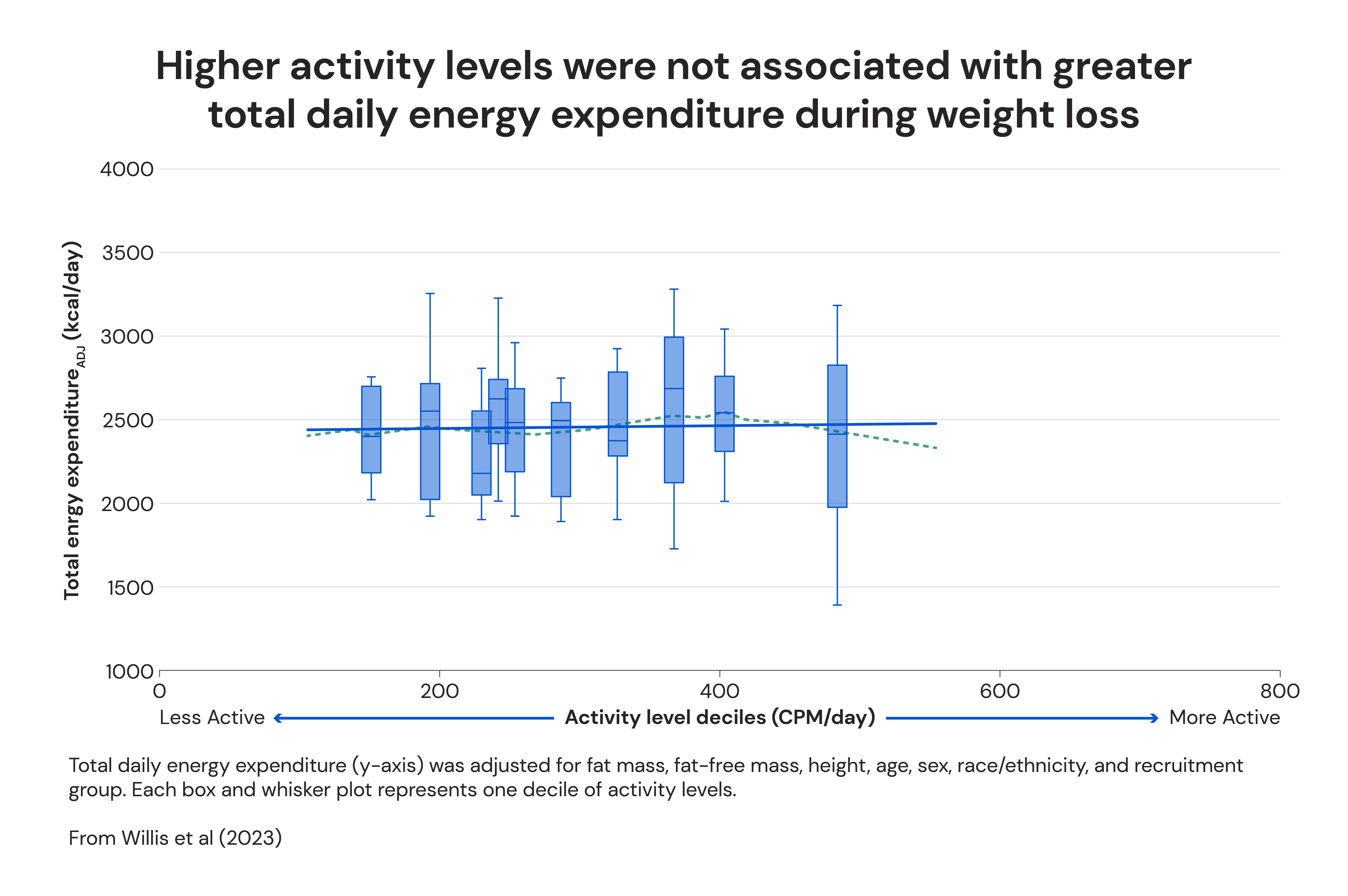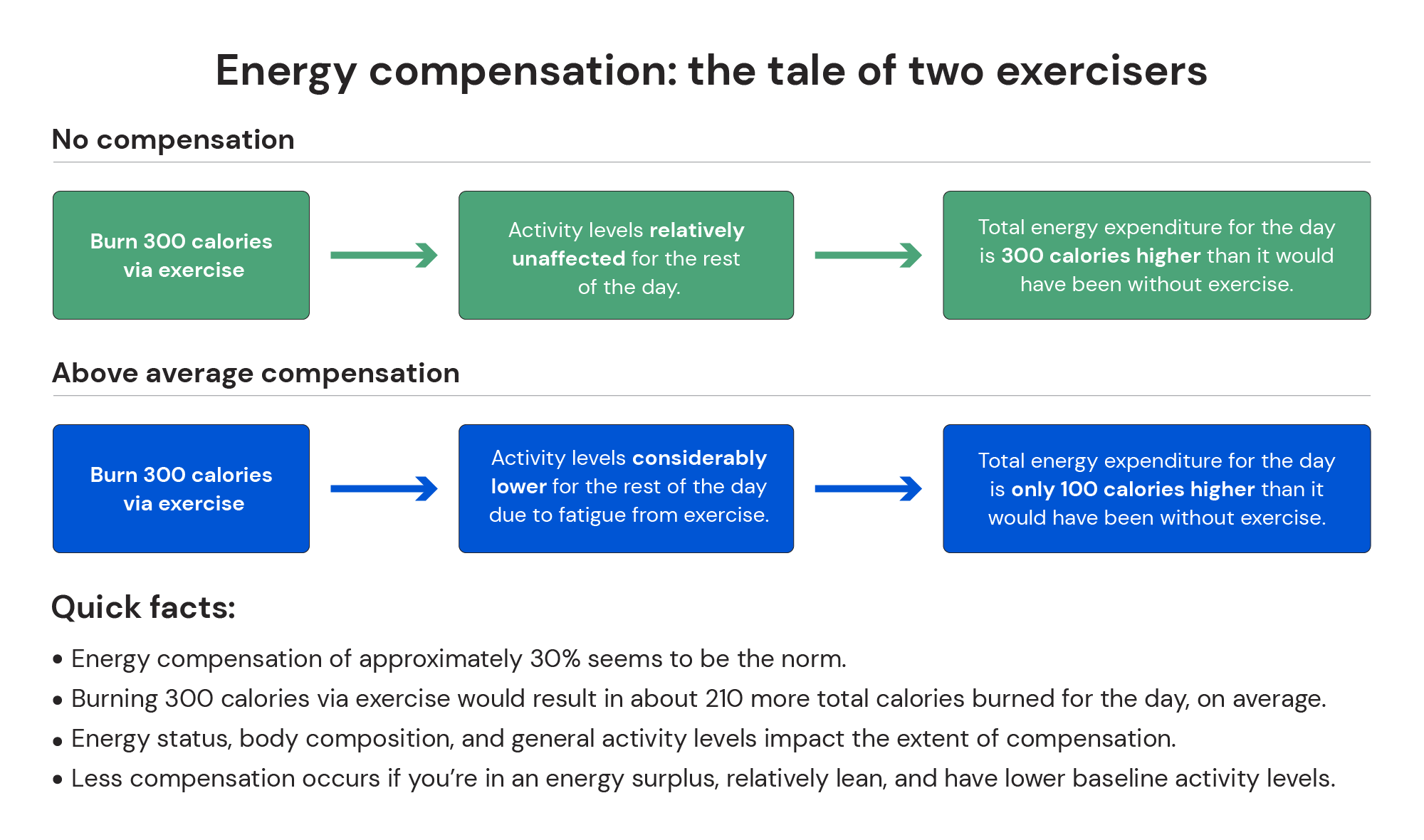It’s natural to assume that increases in exercise will increase your total daily energy expenditure (and therefore your Calorie targets). But, when you start exercising more, your calculated expenditure in MacroFactor may not increase, or may not increase by quite as much as you expect it to.
So, why might that occur?
The most basic answer is that exercise typically has a smaller impact on your total energy expenditure than most people expect. That’s not to say that exercise doesn’t increase your expenditure at all, but if, for example, you burn 100 more Calories via exercise each day, your total daily energy expenditure typically doesn’t increase by 100 Calories in response. There are a few reasons for this.
First, exercising takes time, and the time you spend exercising would have otherwise been spent doing something else. No matter what that “something else” was, it would have burned some Calories. Just to illustrate, if you burn 100 Calories jogging for 15 minutes instead of watching TV, you probably would have still burned 15-20 Calories while watching TV, so the additive energy cost of jogging was a bit smaller (80-85 Calories) than the total energy cost of jogging (100 Calories).
Second, exercising (and attaining higher levels of fitness) increases the efficiency at which your body can turn stored chemical energy into useful physical work. Stated another way, exercise increases your movement economy. So, if running or walking a mile at a particular pace previously burned 100 Calories, increases in movement economy may mean running or walking a mile at the same pace now burns 90 or 95 Calories instead. This is a positive adaptation for improving physical performance (a 10% increase in movement economy essentially means that you can do 10% more work per unit of time – run 10% faster, do 10% more reps, etc. – at the same level of effort and while generating the same amount of energetic fatigue), but it does reduce the energy cost of exercise over time, meaning a discrete amount of exercise burns fewer and fewer Calories as your fitness levels increase.
Third, exercising more may lead to behavioral or metabolic adaptations that reduce energy expenditure during the time you’re not exercising (often referred to as “energy compensation”). For example, if you have a really hard workout, you might be a bit more lethargic the rest of the day, meaning you may fidget a bit less, you may sit down when you otherwise would have been standing, or you might save a trip up or down the stairs you otherwise would have made. Or, your workout might leave you sore the next day, leading to similar (fairly small) behavioral adjustments that end up reducing energy expenditure during the times you’re not exercising. So, you may burn 100 extra Calories during exercise, but you also burn 30 fewer Calories throughout the rest of the day due to reductions in your non-exercise activity, leading to an increase in total energy expenditure of just 70 Calories.
Combine these three factors, and what we generally see is that moderate amounts of exercise do generally increase your total daily energy expenditure compared to being sedentary. But, the impact of further increases in exercise volume tends to be more muted. We see this relationship in both large-sample cross-sectional research, and in intervention studies. For example, in one study, subjects trained for a half marathon over 44 weeks. The initial increase in training volume from 0 to 25 km/week caused a large increase in their total active energy expenditure, but further progressive increases to 50km/week didn’t lead to further increases in energy expenditure.

Finally, being in an energy deficit (i.e. losing weight) amplifies all of these effects. Weight loss causes an additional increase in movement economy (meaning that a fixed amount of exercise burns even fewer Calories), and behavioral and metabolic adaptations to exercise are even larger. For example, one study found that the most active adults (predictably) burned more Calories per day than the least active adults in cohorts of people who were gaining or maintaining weight, but the most and least active adults who were losing weight burned about the same number of Calories per day, on average. Studies with weight loss interventions have had similar findings. Furthermore, weight loss itself tends to progressively reduce your energy expenditure, both because it takes less energy to fuel a progressively smaller body, and because weight loss tends to cause additional reductions in resting energy expenditure.

Put all of that together, and burning 400 additional Calories via exercise may only lead to an increase in total energy expenditure of 250-300 Calories per day when you’re maintaining or gaining weight, and an increase of 150-200 Calories per day (in a vacuum) when you’re losing weight. But, while losing weight, some of that increase will be further offset by the independent impact of weight loss on energy expenditure. So, a 200 Calorie impact of exercise won’t necessarily mean that your energy expenditure increases by 200 Calories – it may instead mean that it increases by 100 Calories when it otherwise would have decreased by 100 Calories were it not for the additional exercise.
To be clear, we’re not saying that exercise has no impact on total daily energy expenditure – we’re just noting that it often has a smaller impact than you’d likely expect, especially during weight loss. Increases in exercise are more likely to increase your total energy expenditure to a larger extent if:
You’re gaining or maintaining weight (the impact is smaller for people who are losing weight).
You’re currently sedentary or doing relatively small amounts of exercise (the impact is smaller for people who are already quite active).
You’re naturally leaner (the impact is smaller for people with higher body fat levels).

Energy compensation is one of the major reasons why your expenditure in MacroFactor may differ substantially from the estimate of your energy expenditure provided by a fitness wearable. A smartwatch only knows your heart rate and how much you’re moving, and it has to assume that energy expenditure has constant and consistent scaling relationships with heart rate and movement. But, the nature of those relationships can change as your total activity levels change, or as you gain or lose weight.
Two final caveats:
First, increases in exercise do tend to lead to smaller increases in total energy expenditure when people are already quite active, but that doesn’t necessarily mean that there’s not a point past which extreme levels of exercise basically have to increase total energy expenditure. For example, athletes with high training loads tend to have total daily energy expenditures that are around twice their BMR, but they can have sustained energy expenditures ~25-50% higher than that (~2.5-3-times BMR) during prolonged competitions (like the Tour de France or weeks-long ultramarathons) where their exercise loads increase even further. In other words, energy compensation is finite, but it’s also not realistic for most people to pursue the exercise loads that would be required to break through the energy compensation plateau.
Second, don’t let this dissuade you from exercising. Exercise has a host of benefits beyond its direct impact on energy expenditure. It helps you build strength, increase your aerobic fitness, improve or maintain your bone mineral density, improve the composition of the weight you gain or lose, achieve long-term weight loss maintenance, maintain a higher metabolism later in life, improve appetite regulation, reduce anxiety, improve or maintain cognition, reduce your risk of numerous chronic diseases, and so much more. Ironically, many people start exercising for the primary purpose of burning more Calories, without too much thought for “everything else”; however, exercise significantly and reliably improves “everything else” to a much greater extent than it (typically) increases daily Calorie burn.
To wrap up, we’d just like to note that you don’t really need to overthink any of this while using MacroFactor. If changing your exercise habits does significantly increase or decrease your energy expenditure, that increase will show up on the scale (your rate of weight change will increase or decrease at a given level of energy intake), and MacroFactor will be able to identify that change and adjust appropriately. Conversely, if an increase in exercise doesn’t have much of an impact on your total energy expenditure, that (lack of) impact will also show up on the scale (i.e. your rate of weight change at a given level of energy intake won’t change much). So, regardless of whether you experience a lot of energy compensation, a little energy compensation, or no energy compensation at all in response to a change in exercise habits, MacroFactor will remove any guess work and make any necessary adjustments to your Calorie targets.